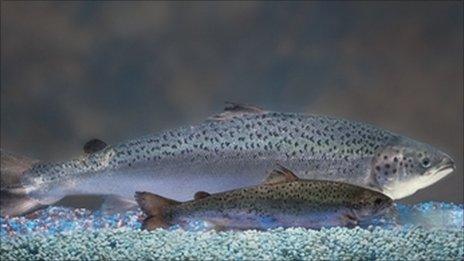Is GM salmon swimming against the tide?
- Published

Comparison of GM salmon and a non-GM salmon (foreground) of the same age
Genetically modified (GM) salmon is safe to eat, according to the US Food and Drug Administration (FDA).
The issue of GM foods is controversial but Ron Stotish of Aqua Bounty, the US company which pioneered the procedure, says the GM salmon is the most studied product in the history of fish.
"This salmon has been the subject of many years of investigation by the FDA, which is uniquely positioned to be able to evaluate the safety of acceptability," he says.
But such assurances do not satisfy Michael Hansen, senior scientist for the US Consumers Union, who says research behind the fish has been "sloppy, misleading and woefully inadequate".
There is further concern that deliberations have been behind closed doors and moreover, all the data has been provided by Aqua Bounty - which stands to make money if this GM salmon is approved.
"Consideration of this gene-spliced salmon needs to move beyond the closed doors of the FDA and into the daylight where the public can weigh in whether this risky development is desired," says Alaska Senator Mark Begich.
For his part, Mr Stotish asserts: "It is quite clear that the people who have criticised this project have not read the data the FDA has released."
Increasing demand
Salmon is a popular and healthy food and more than half sold in the US is farmed - in an aquaculture industry worth $80bn (拢50bn).
However, the science behind any GM product is highly controversial and consumers question the impact on human health and the environment.
The fish eggs are female and sterile so they cannot interbreed if they escape into the wild
Mr Stotish explains that his company is pushing ahead with the project despite fierce vocal opposition.
"Increased demand for high-quality seafood protein had led us to the conclusion that there is a need, and also that this product has unique identifiable benefits for the consumer and the environment," he says.
"By 2020, the global demand for animal protein is projected to be 20 million tonnes per year. We will help address that need by producing more fish in less time compared to current salmon farming techniques."
Aqua Bounty's salmon has been modified with growth gene from a Chinook salmon and an antifreeze gene from an eel, the ocean pout.
The genetic modifications are intended to speed the growth rate of the hybrid-engineered species.
Labelling issues
In the US, food requires labelling for identity, for nutrition and for potential allergic reactions. There is no requirement for additional labelling.
The FDA concludes there is "no biologically relevant difference" between the Aqua Bounty engineered fish and regular Atlantic salmon.
Therefore, under current law, it would not have to be labelled as being GM.
"The fish produced is identical to traditional fish. We encourage people to label the products voluntarily for its attributes, that it is safe and healthy and environmentally sustainable," Mr Stotish says.
"We are in the business of selling eggs. We will sell to growers who are approved, so their facilities are approved by the FDA," he adds.
Senator Begich says that if the FDA moves ahead with certification of the hybrid salmon, he will introduce legislation to require any such animal products on the market be labelled as "genetically engineered".
Contamination concerns
"Let's call this genetically engineered fish for what it is: Frankenfish," says Senator Begich.
"Approval of genetically modified salmon, the first such hybrid to be considered for human consumption, is unprecedented, risky and a threat to the survival of wild species," he asserts.
Along with other critics of GM food, he is concerned that they might damage the environment if they escape into the wild. They fear the technology could lead to the creation of mutant, misshapen fish and could harm wild fish populations if they escape.
Research on GM trout in Canada found that while they grew faster and were much bigger, a number developed misshapen heads and bloated bodies.
But according to Aqua Bounty, their engineered salmon are all female, they are all sterile, and they are raised in physically contained facilities, and they consider the prospect of their fish being able to breed in the wild as negligible.
Alaska's stance
Alaska made the decision 20 years ago to ban farmed salmon and other such fish in its waters and focused instead on management practices that sustain and grow wild salmon.
"Alaska's management of wild fish stocks is considered among the best in the world and as a result, we've seen catches soar to above 200 million salmon in recent years," says Senator Begich.
Fishermen harvested over 160 million salmon in 2010, worth $400m to Alaskan communities which depend largely on harvests of wild salmon production to support local economies and subsistence needs.
Fish are grown in outdoor ponds or in large tanks in a more secure environment
Salmon farms elsewhere have been criticised for crowded conditions, fecal contamination, use of chemicals, proliferation of disease and escapees.
Atlantic salmon have been documented in Alaska's Pacific waters, escapees from neighbouring fish farms. Many are infested with sea lice and are considered an invasive species.
In Scotland, meanwhile, salmon farming is an important rural industry worth more than 拢400m a year.
Scott Landsburgh, of the Scottish Salmon Producers' Organisation, says: "The growth of genetically modified salmon is not permitted in Scotland and I do not foresee that changing any time soon."
Scotland currently exports fish to 55 countries, but if the US venture gains ground in the market, the industry might ultimately have to reconsider its position.